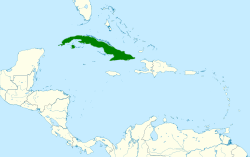| Cuban trogon | |
|---|---|
 | |
| A tocororo in Viñales Valley, Cuba | |
| Scientific classification | |
| Kingdom: | Animalia |
| Phylum: | Chordata |
| Class: | Aves |
| Order: | Trogoniformes |
| Family: | Trogonidae |
| Genus: | Priotelus |
| Species: | P. temnurus |
| Binomial name | |
| Priotelus temnurus (Temminck, 1825) | |
 | |
The Cuban trogon or tocororo (Priotelus temnurus) is a species of bird in the family Trogonidae. It is endemic to Cuba, where it is also the national bird.




